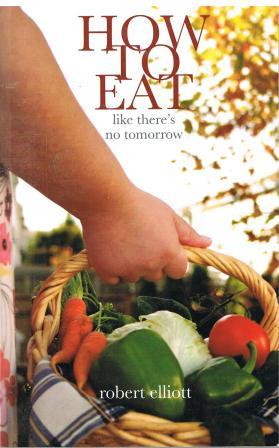Succinctly speaking
Let's meet Robert Elliot.
In order to keep the page short just now, his career etc comes later. Here's a good introduction. The numbers have been added.:
1a
The idea of collecting items of pre-packaged food amidst hordes of strangers to whom we don't speak, in an artificially lit warehouse full of the colourfully wrapped, nutritionally depleted products of profit-driven factories has been sold-to us as being a life-enhancing concept. This is simply because advertising psychology has identified that we will respond positively to the two clarion calls of convenience and cheapness.
1b
Because we are all for an easy life, we remain convinced that we are behaving quite naturally. However, the only natural elements in all this are the basic human instincts which have been manipulated by the marketing industry to lead us into a behaviour pattern that suits their need for predictable and profitable bottom-line results. Good for profitability, but bad for us, it has been argued by Barry Groves in his book, Trick and Treat, that 90% of what is now available in the supermarket is so unnatural that it is technically unfit for human consumption.

The text is from the book, page 18. more
Panel 2
Convenience
2a
A study carried out in the early 1990s demonstrated that pedestrians’ speed of walking provides a reliable measure of the pace of life in a city, and that people in fast-moving cities are less likely to help others and have higher rates of coronary heart disease. Using identical methods to those employed in the previous work, the present day research teams discovered that the pace of life is now 10% faster than in the early 1990s. less succinctly
2b
Find out if you are living life in the fast lane by completing our short quiz here. from 2a
2c
.... pace of life was fastest in Japan and the countries of Western Europe and was slowest in economically undeveloped countries. The pace was significantly faster in colder climates, economically productive countries, and in individualistic cultures. Faster places also tended to have higher rates of death from coronary heart disease, higher smoking rates, and greater subjective well-being. Discussion focuses on how the pace of life is intertwined with the social-psychological and community characteristics of a culture, and the central role of pace of life in defining the personality of a place and its people. source
2d
Have we gained anything but faster pace since 1877?
Beyond doubt, the most salient characteristic of life in this latter
portion of the 19th century is its SPEED,—what we may call its hurry,
the
rate at which we move, the high-pressure at which we work; — and the question to be considered is, first, whether this rapid rate is in itself a good; and, next, whether it is worth the price we pay for it — a price reckoned up, and not very easy thoroughly to ascertain.
That came from a link in 2c. The quote is from p 2 here. Surrounding discussion is less succinct.
2e
We can leave the cheapness from 1a to another time.